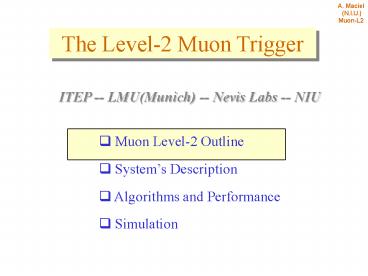Muon Level-2 Outline - PowerPoint PPT Presentation
1 / 10
Title:
Muon Level-2 Outline
Description:
(2)ALPHA preprocessor (track assembly) (3) GLOBAL Level-2 (trigger decisions) ... Segments built from both wire and scintillator elements. ... – PowerPoint PPT presentation
Number of Views:24
Avg rating:3.0/5.0
Title: Muon Level-2 Outline
1
A. Maciel (N.I.U.) Muon-L2
The Level-2 Muon Trigger
ITEP -- LMU(Munich) -- Nevis Labs -- NIU
- Muon Level-2 Outline
- Systems Description
- Algorithms and Performance
- Simulation
2
Muon Level-2 Outline
A. Maciel (N.I.U.) Muon-L2
Data processing happens in three stages
(1) SLICs (track segment finding)
(C-code on T.I. DSPs)
INPUT PROCESSING OUTPUT
Muon Front End Data L1 Data
Pattern Recognition Re-Format
A - Layer Track Stubs BC-Layer Track
Stubs L1-objects (Aphi)
(2)ALPHA preprocessor (track assembly)
(C on Linux)
?Compare all SLIC reported objects, search for
matches ?Assemble matches (or singles) into final
L2 muon candidates ?Report track params. and
ID-quality to L2(global) and L3(seeds)
(3) GLOBAL Level-2 (trigger decisions)
(C on Linux)
- Relate muon L2 candidates to other L2 objects,
report triggers
3
L2-Global Muon Candidates
A. Maciel (N.I.U.) Muon-L2
- Global L2 has two main functions
- Muon selection (Number, Pt, h-range, Track-Q,
Time-Q) - object relations ( JET , EM , MEt , MU , TRK ,
IP ) - Examples of Muon relations
- Angular separation, Dimuon mass CFT resolution
- Isolation, muon inside jet, track match
(Pt,?,f) , IP - Global can request object matches, but cannot do
track re-fits, or ID building beyond CFT(Pt,?,f) - SLICs and ALPHAs do the object-ID building
- Global is responsible for the rejection
4
L1
L2
L3
5 MHz
10 KHz
1 KHz
20 Hz
Expected L1 Muon Rates (KHz)
L1 muon bandwidth few KHz
Pt ? 4 GeV (2,2)GeV (2,4)GeV
? lt 1 1 0.2
? lt 1.5 2 2 0.2
? lt 2 4 10
- We can expect a rate reduction 2 from
tracking - Extra rejection can come from
- Tighter time gates
- Event-wide inspection
L2
gt
single track
L2 is more of a physics trigger than an object-ID
trigger
5
Overview of Muon L2 Algorithms
A. Maciel (N.I.U.) Muon-L2
- Pre-Global muon ID is based on muon system only,
no cross referencing among different subdetectors
(L1 CFT Pt-thresh). - Track segment finding for A and BC layers
separately. Run1 Pt. - Segments built from both wire and scintillator
elements. - Calib central wires have drift and f(?T), Scints
are T0 subtracted. - L2 reports single-cell-wide 3D tracks in (Pt,?,f)
coordinates. - Central PDT (A)segments must satisfy track
residual requirements. - No vertexing, but hit patterns must be compatible
with int. region. - Added resolution (over L1) in track counting,
pointing and timing. - L2 candidate searches are not biased by or
related to L1 results.
6
- L2 Impact on L1 Muon-ID
- Smallest granularity 3D tracking, improved
wire-scint and L-L correl - More accurate object counting removes
multiple triggers (stubs) resolves closely spaced
tracks - Pt matching to L1 threshold
- Narrower rejection time gate
- Scint-TOF discrimination for Prompt - Slow - Out
of Time - Recover crossing octant tracks
- ? dependence of hit patterns
L1 Muon ID
MTC05
non-CFT fwd.
region wide scint match (f wedge)
CFT f wedge
dimuons
MTC10
punch
calib
octant wide scint match (? wedge)
MSP searches
(Pt,?,f)
PDT centroid
pointing
A. Maciel (N.I.U.) Muon-L2
7
SLIC
A. Maciel (N.I.U.) Muon-L2
channel 0 L1 (SCL)
channel 1 Front Ends
channel 2 Front Ends
channel 15 Front Ends
output to MBT
16 inputs
event size reduction 20
input fpgas set headers, trailers, word counts,
DSP routing bits
channel-0 and DSP-5 are responsible for event
alignment
fpga
fpga
fpga
fpga
fpga
FIFO
FIFO
FIFO
FIFO
FIFO
1
3
4
5
2
DSP
DSP
DSP
DSP
DSP
monitor,
sort format
physics
physics
physics
physics
8
(No Transcript)
9
(No Transcript)
10
A. Maciel (N.I.U.) Muon-L2
The Level-2 Muon Trigger
ITEP LMU(Munich) -- Nevis Labs -- NIU
- Muon Level-2 Outline
- Systems Description
- Algorithms and Performance
- Simulation
2nd part of talk on a different file































